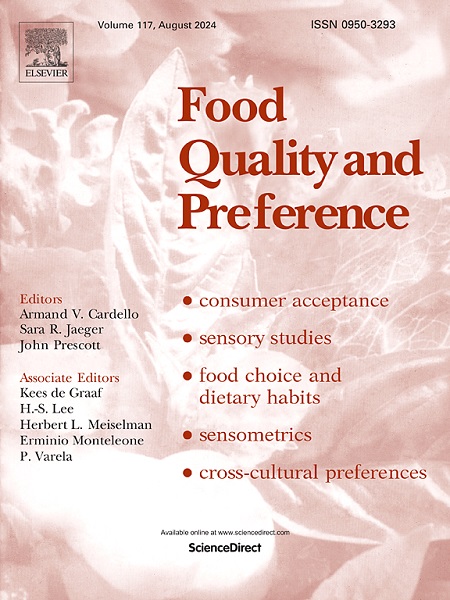儿童(8-16岁)和成人对燕麦香草风味冷冻甜点的感官知觉和偏好
IF 4.9
1区 农林科学
Q1 FOOD SCIENCE & TECHNOLOGY
引用次数: 0
摘要
近年来,受环境、动物福利和健康问题的推动,对植物性替代品的需求显著增长。这项研究的重点是燕麦冷冻甜点,以乳制品为基础的冰淇淋作为参考,研究儿童(8-16岁)和成人(n = 210;爱沙尼亚和拉脱维亚各105个)。探索不同的群体如何看待这些产品,将表明在产品开发中应该关注什么。虽然所有的样品都被评为总体上令人愉快,但味道成为整体愉悦度的主要驱动因素。乳制品冰淇淋在所有人群中都获得了最高的评分,这与“香草”、“甜”、“黄油”、“乳白色”和“天然”等感官品质有关,也与“更油腻”和“更奶油”的质地有关,这可能是由乳脂增强的。在以燕麦为基础的样品中,最不令人愉快的样品表现出异味,可能是由添加的调味剂而不是植物成分引起的,因为所有以燕麦为基础的产品的“植物”细微差别是一致的。孩子们对“异味”和“植物味”的关注程度较低,这可能是由于孩子们的感官期望更简单。拉脱维亚人也表现出类似的趋势,这可能与拉脱维亚的冰淇淋消费量比爱沙尼亚低有关,导致人们的期望更低。这些发现强调了改善燕麦冷冻甜点感官属性的必要性,特别是通过风味和可能的质地改进。提高这些特征对于提高消费者的接受度,尤其是那些更熟悉乳制品的消费者的接受度至关重要。将这些改进与有针对性的营销策略结合起来,可以进一步提高对植物性冷冻甜点的接受度和消费量。本文章由计算机程序翻译,如有差异,请以英文原文为准。
Sensory perception and preferences of oat-based vanilla-flavoured frozen desserts among children (aged 8–16) and adults
The demand for plant-based alternatives has grown significantly in recent years, driven by environmental, animal welfare, and health concerns. This study focused on oat-based frozen desserts, with dairy-based ice cream included as a reference, examining sensory perception and overall pleasantness among children (8–16 years) and adults (n = 210; 105 each) in Estonia and Latvia. Exploring how different groups perceive these products would indicate what to focus on in product development. While all samples were rated as generally pleasant, flavour emerged as the primary driver of overall pleasantness. Dairy-based ice cream consistently received the highest ratings across all groups, linked to sensory qualities like “vanilla,” “sweet,” “buttery,” “milky,” and “natural”, as well as its “fattier” and “creamier” texture, likely enhanced by milk fat. Among oat-based samples, the least pleasant sample exhibited off-notes, likely caused by added flavouring rather than plant-based ingredients, as “vegetal” nuances were consistent across all oat-based products. Children were less attentive to “off-flavour” and “vegetal” flavours, possibly due to children's simpler sensory expectations. Similar tendency was shown with Latvians, which could be related to lower ice cream consumption in Latvia compared to Estonia, leading to less defined expectations. These findings highlight the need to improve the sensory attributes of oat-based frozen desserts, particularly through flavour and possibly texture refinement. Enhancing these characteristics is essential to increasing consumer acceptance, especially among those more familiar with dairy products. Aligning these improvements with targeted marketing strategies could further boost the acceptance and consumption of plant-based frozen desserts.
求助全文
通过发布文献求助,成功后即可免费获取论文全文。
去求助
来源期刊

Food Quality and Preference
工程技术-食品科技
CiteScore
10.40
自引率
15.10%
发文量
263
审稿时长
38 days
期刊介绍:
Food Quality and Preference is a journal devoted to sensory, consumer and behavioural research in food and non-food products. It publishes original research, critical reviews, and short communications in sensory and consumer science, and sensometrics. In addition, the journal publishes special invited issues on important timely topics and from relevant conferences. These are aimed at bridging the gap between research and application, bringing together authors and readers in consumer and market research, sensory science, sensometrics and sensory evaluation, nutrition and food choice, as well as food research, product development and sensory quality assurance. Submissions to Food Quality and Preference are limited to papers that include some form of human measurement; papers that are limited to physical/chemical measures or the routine application of sensory, consumer or econometric analysis will not be considered unless they specifically make a novel scientific contribution in line with the journal''s coverage as outlined below.
 求助内容:
求助内容: 应助结果提醒方式:
应助结果提醒方式:


